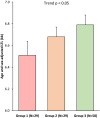Number and Replating Capacity of Endothelial Colony-Forming Cells are Telomere Length Dependent: Implication for Human Atherogenesis
- PMID: 33955230
- PMCID: PMC8200696
- DOI: 10.1161/JAHA.120.020606
Number and Replating Capacity of Endothelial Colony-Forming Cells are Telomere Length Dependent: Implication for Human Atherogenesis
Abstract
Background Short leukocyte telomere length (TL) is associated with atherosclerotic cardiovascular disease. Endothelial repair plays a key role in the development of atherosclerosis. The objective was to examine associations between TL and proliferative dynamics of endothelial colony-forming cells (ECFCs), which behave as progenitor cells displaying endothelial repair activity. Methods and Results To isolate ECFCs, we performed a clonogenic assay on blood samples from 116 participants (aged 24-94 years) in the TELARTA (Telomere in Arterial Aging) cohort study. We detected no ECFC clones in 29 (group 1), clones with no replating capacity in other 29 (group 2), and clones with replating capacity in the additional 58 (group 3). Leukocyte TL was measured by Southern blotting and ECFCs (ECFC-TL). Age- and sex-adjusted leukocyte TL (mean±SEM) was the shortest in group 1 (6.51±0.13 kb), longer in group 2 (6.69±0.13 kb), and the longest in group 3 (6.78±0.09 kb) (P<0.05). In group 3, ECFC-TL was associated with the number of detected clones (P<0.01). ECFC-TL (7.98±0.13 kb) was longer than leukocyte TL (6.74±0.012 kb) (P<0.0001) and both parameters were strongly correlated (r=0.82; P<0.0001). Conclusions Individuals with longer telomeres display a higher number of self-renewing ECFCs. Our results also indicate that leukocyte TL, as a proxy of TL dynamics in ECFCs, could be used as a surrogate marker of endothelial repair capacity in clinical and laboratory practice because of easy accessibility of leukocytes. Registration URL: https://www.clinicaltrials.gov; Unique identifier: NCT02176941.
Keywords: aging; endothelial progenitor cell; telomere.
Conflict of interest statement
None.
Figures





References
Publication types
MeSH terms
Associated data
Grants and funding
LinkOut - more resources
Full Text Sources
Medical

